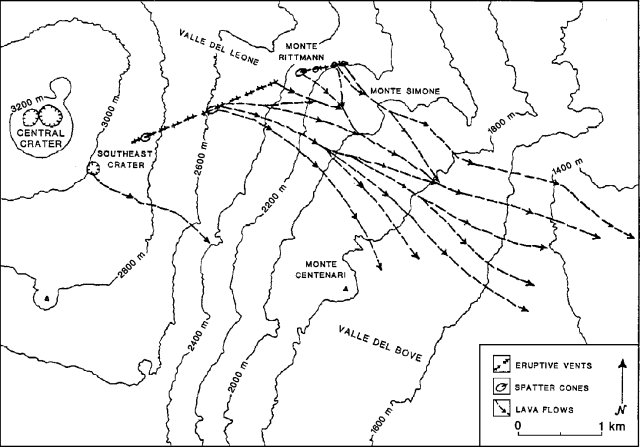Report on Etna (Italy) — November 1986
Scientific Event Alert Network Bulletin, vol. 11, no. 11 (November 1986)
Managing Editor: Lindsay McClelland.
Etna (Italy) Fissure eruption continues
Please cite this report as:
Global Volcanism Program, 1986. Report on Etna (Italy) (McClelland, L., ed.). Scientific Event Alert Network Bulletin, 11:11. Smithsonian Institution. https://doi.org/10.5479/si.GVP.SEAN198611-211060
Etna
Italy
37.748°N, 14.999°E; summit elev. 3357 m
All times are local (unless otherwise noted)
"The eruption ... was continuing in early December. As of 9 December, two eruptive vents were still active, as was a pit crater at ~ 2,850 m altitude (figure 25) that generally showed strong gas emission but at times (15 November) violent expulsions of ash and/or sporadic ejection of incandescent material. A substantial spatter cone has formed at the eruptive vent at 2,600 m altitude, from which strong gas emissions have occurred since mid-November. The main lava channel originated at the base of the cone, and since the end of November has been an essentially continuous lava tube (with at least seven skylights in its roof) down to 1,900-2,000 m altitude, where a few ephemeral effusive vents have formed. Several lava flows fanned out from these vents, rarely going below 1,500 m and remaining within the Valle del Bove. The more active lava flows have generally moved E. On 19 November one of these reached 1,325 m altitude, ~ 5 km from the vent.
 |
Figure 25. Sketch map of Etna's summit area and E flank showing new fissures, lava flows, and spatter cones. |
"A large spatter cone (called Monte Rittmann in memory of our beloved teacher) formed around 2,300-2,350 m, and reached a height of ~ 100 m. From its base, a lava overflow started at the beginning of December and fed a flow that advanced ~700 m before stopping behind Monte Simone. Monte Rittmann has shown almost continuous Strombolian activity, more or less violent and often accompanied by strong explosions. Expulsions of ash have also been observed. The eruptive vents at lower elevation have not been active since 25 November. These vents, one exclusively explosive (at ~ 2,250 m altitude) and two primarily effusive (2,200 and 2,190 m altitude) were very active during the first weeks of the eruption, helping to form a large lava field. The flow fronts were generally wide (at times > 100 m) and high (at times > 10 m). An initial estimate, still to be confirmed, suggests that the volume of lava is around 25 x106 m3. It is difficult at this time to evaluate the surface covered by the lava, but it should be > 4 km2.
"From the E vent of the central crater (the Chasm) more or less violent emissions of reddish ash have continued without interruption. Only emissions of gas and vapor were recorded from the other summit-area vents.
"Only a few weak earthquakes were recorded during November and the first few days of December. Volcanic tremor remained at high levels (5-10x normal), with variations related to changes in the eruptive activity."
Geological Summary. Mount Etna, towering above Catania on the island of Sicily, has one of the world's longest documented records of volcanism, dating back to 1500 BCE. Historical lava flows of basaltic composition cover much of the surface of this massive volcano, whose edifice is the highest and most voluminous in Italy. The Mongibello stratovolcano, truncated by several small calderas, was constructed during the late Pleistocene and Holocene over an older shield volcano. The most prominent morphological feature of Etna is the Valle del Bove, a 5 x 10 km caldera open to the east. Two styles of eruptive activity typically occur, sometimes simultaneously. Persistent explosive eruptions, sometimes with minor lava emissions, take place from one or more summit craters. Flank vents, typically with higher effusion rates, are less frequently active and originate from fissures that open progressively downward from near the summit (usually accompanied by Strombolian eruptions at the upper end). Cinder cones are commonly constructed over the vents of lower-flank lava flows. Lava flows extend to the foot of the volcano on all sides and have reached the sea over a broad area on the SE flank.
Information Contacts: R. Romano, T. Caltabiano, D. Condarelli, and O. Consoli, IIV; S. Gresta, Univ di Catania.

